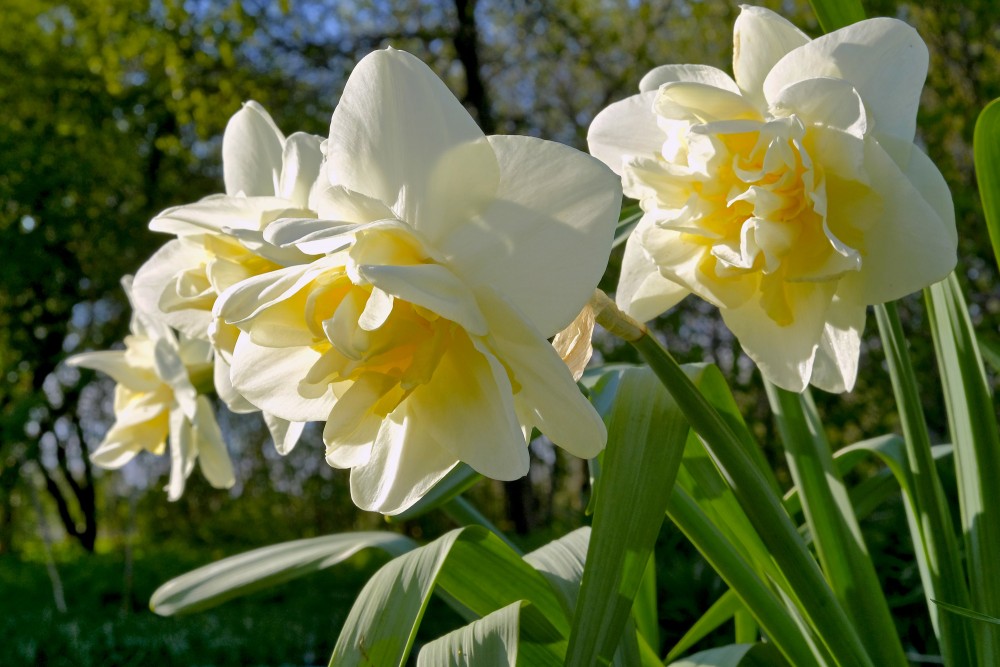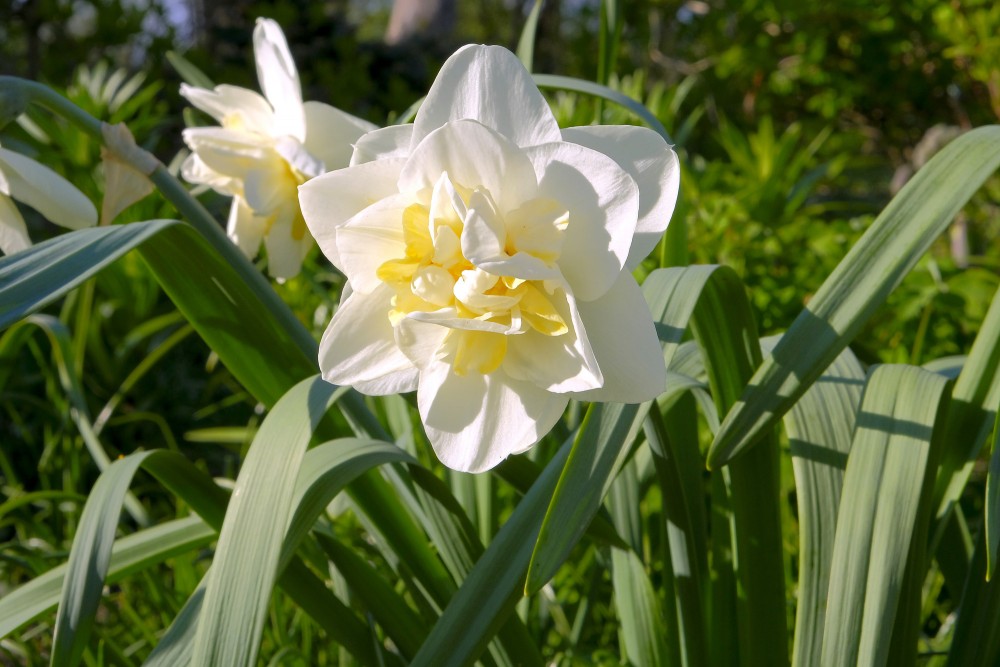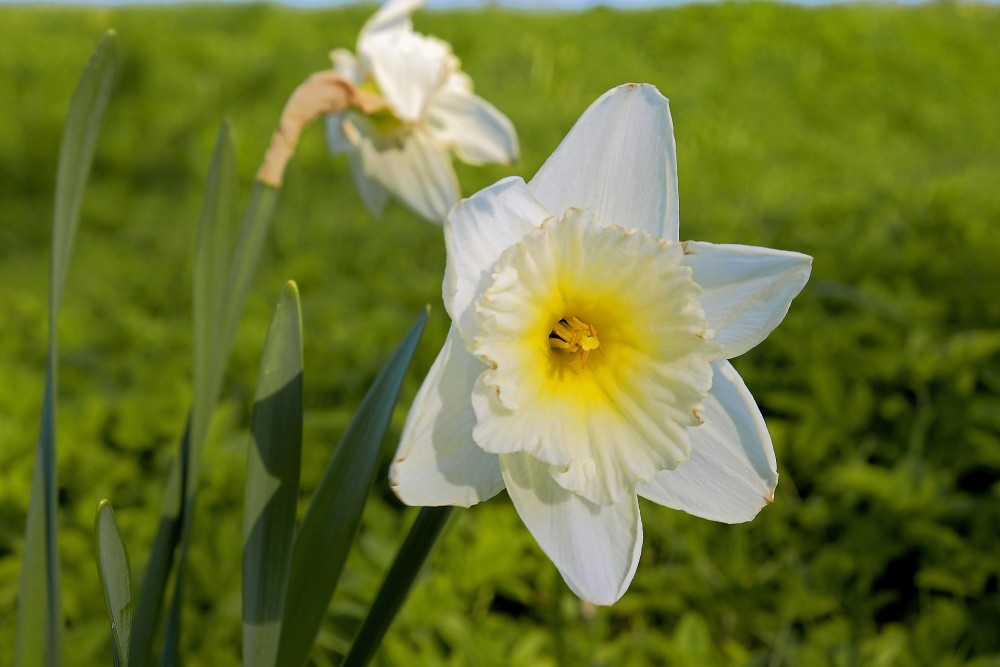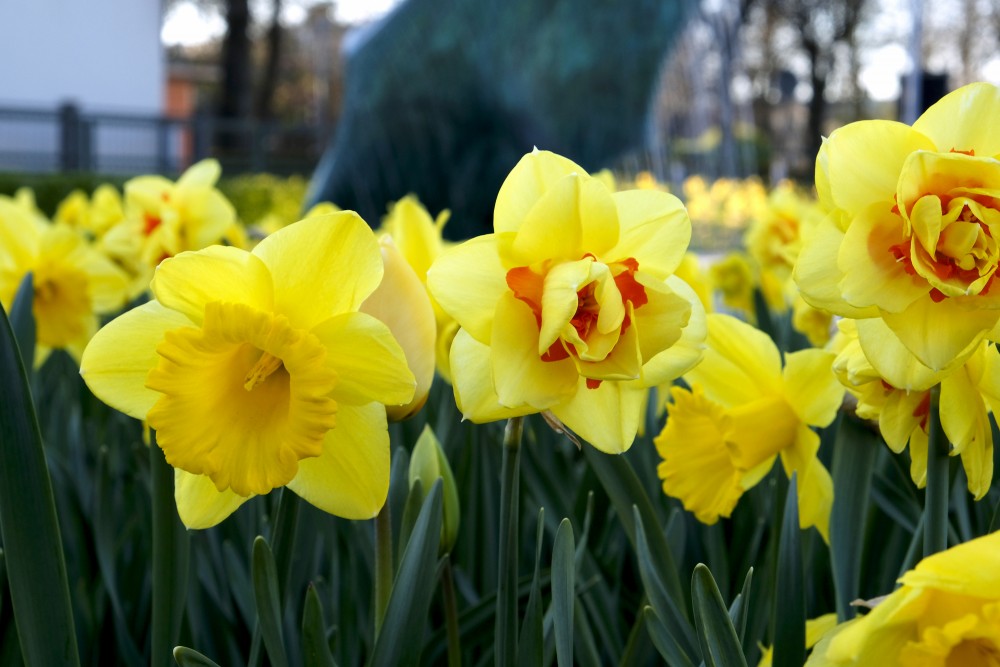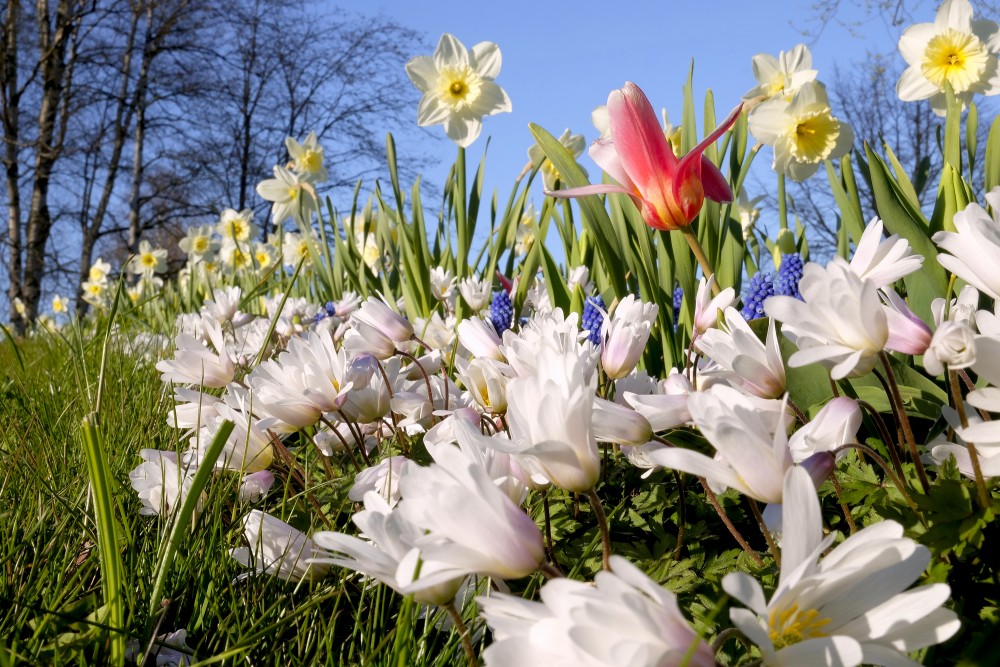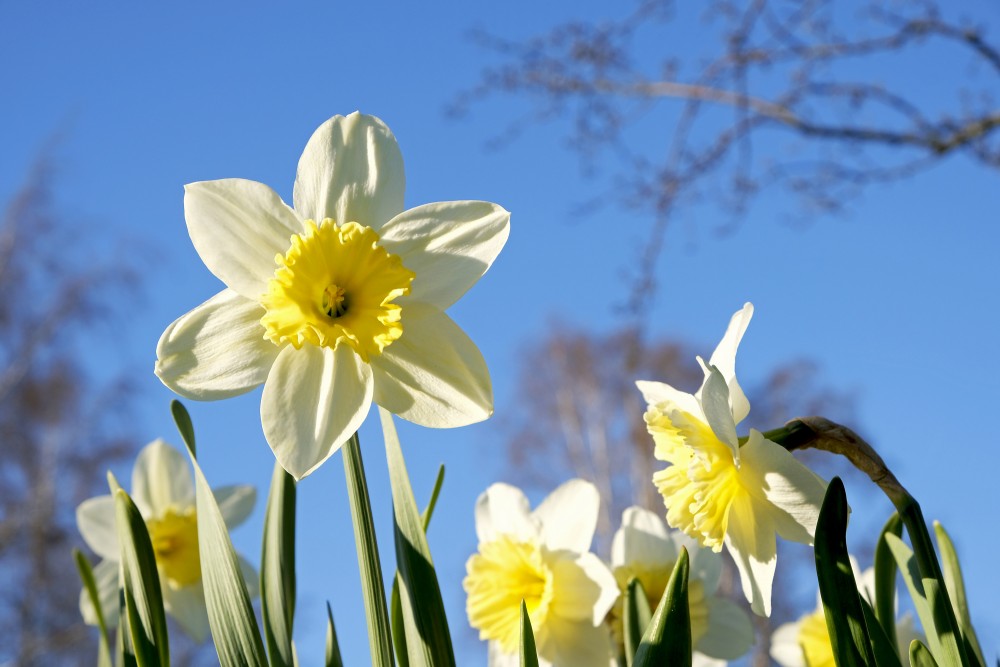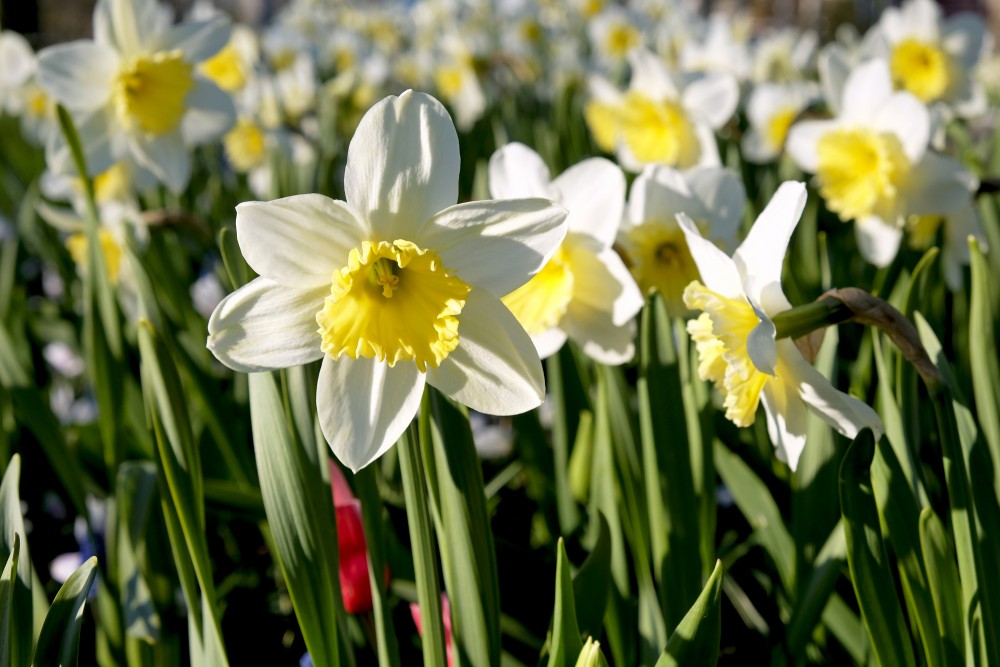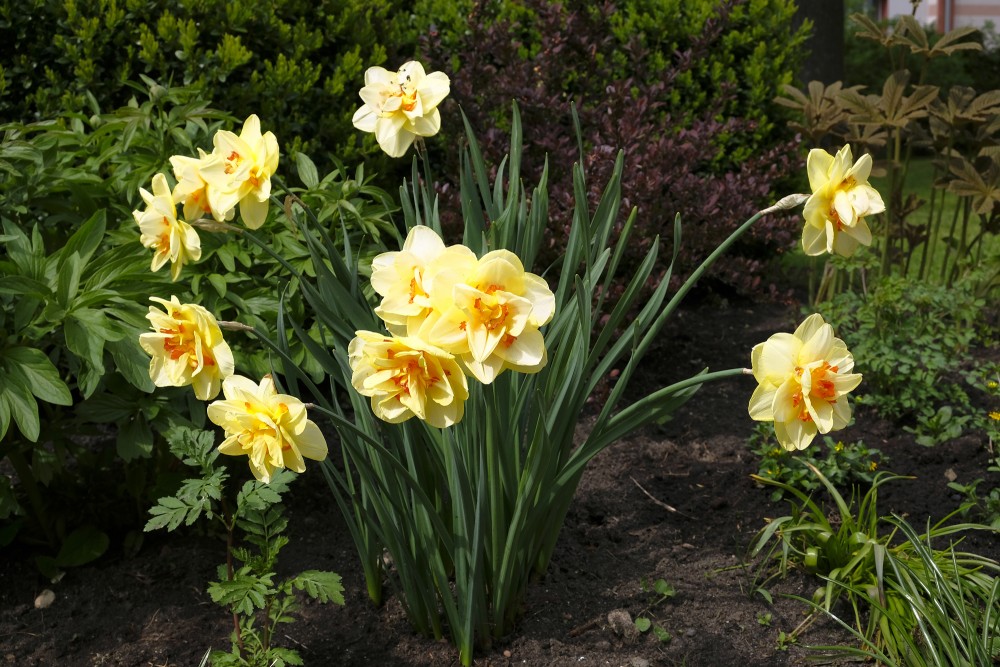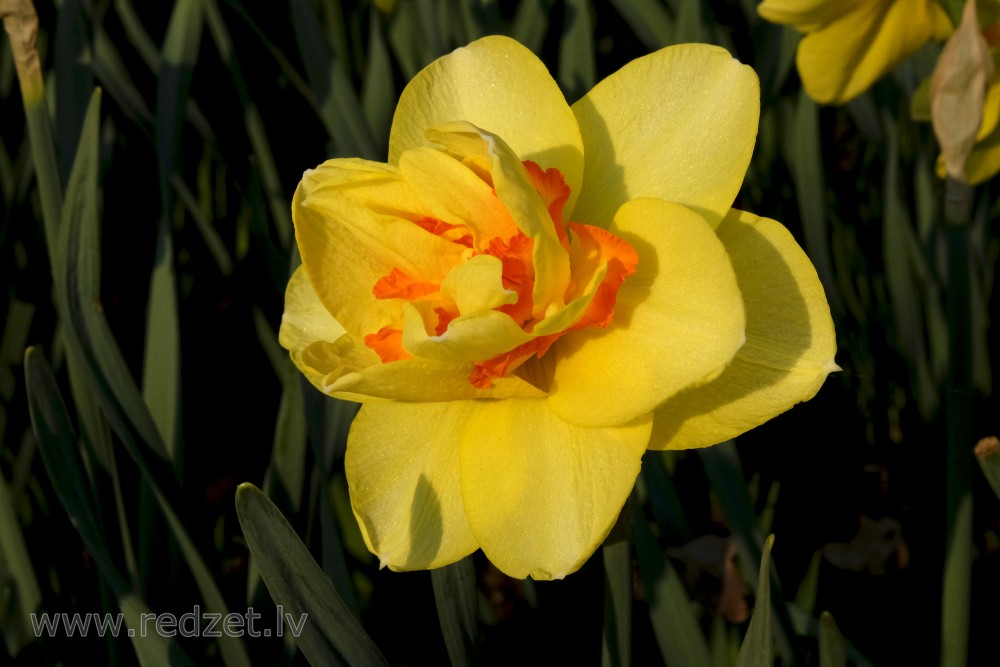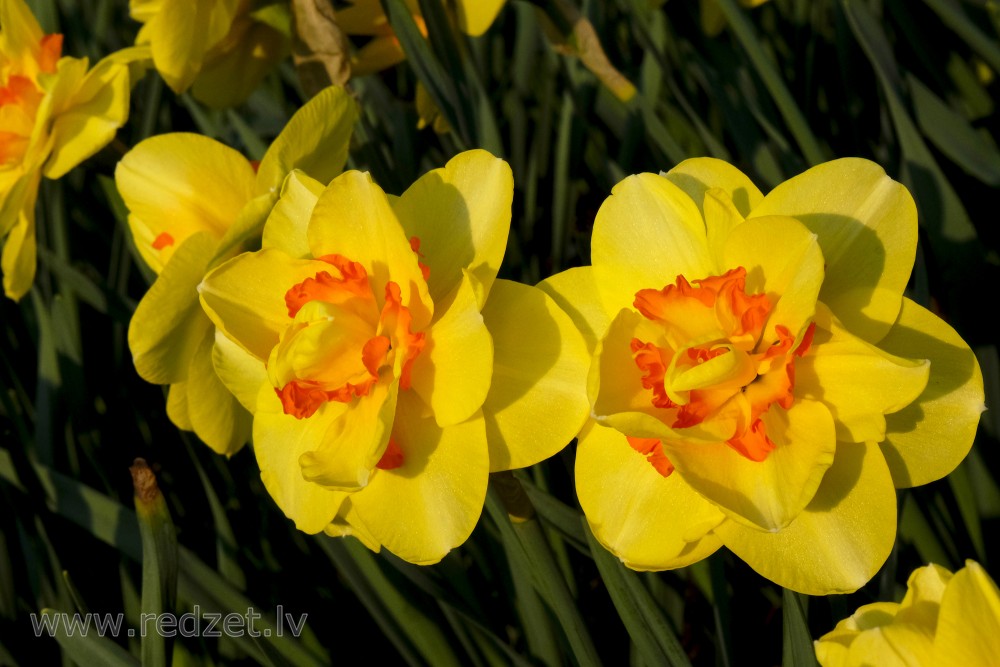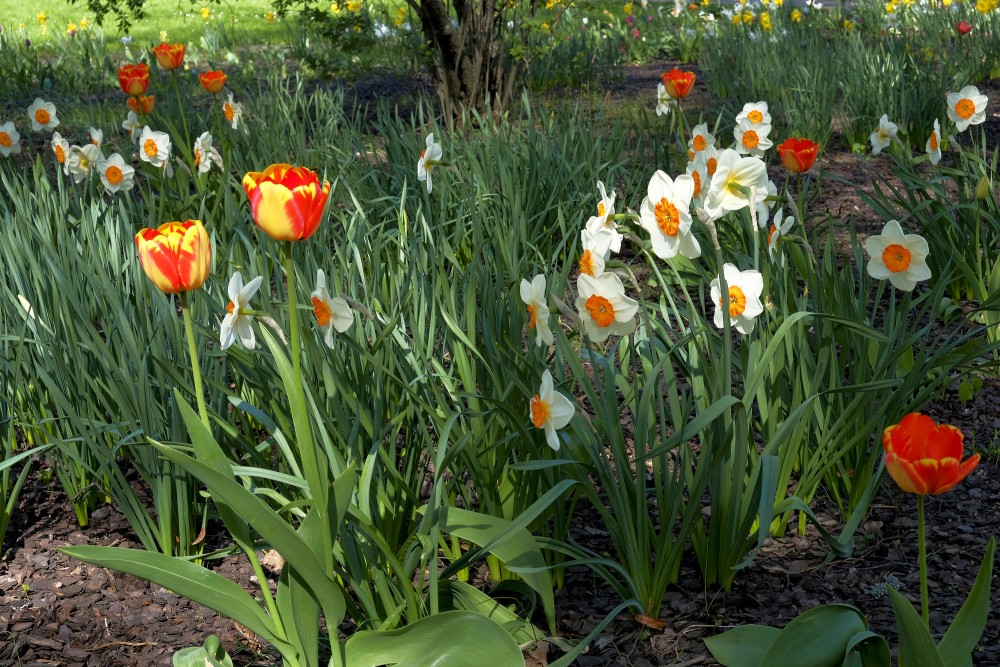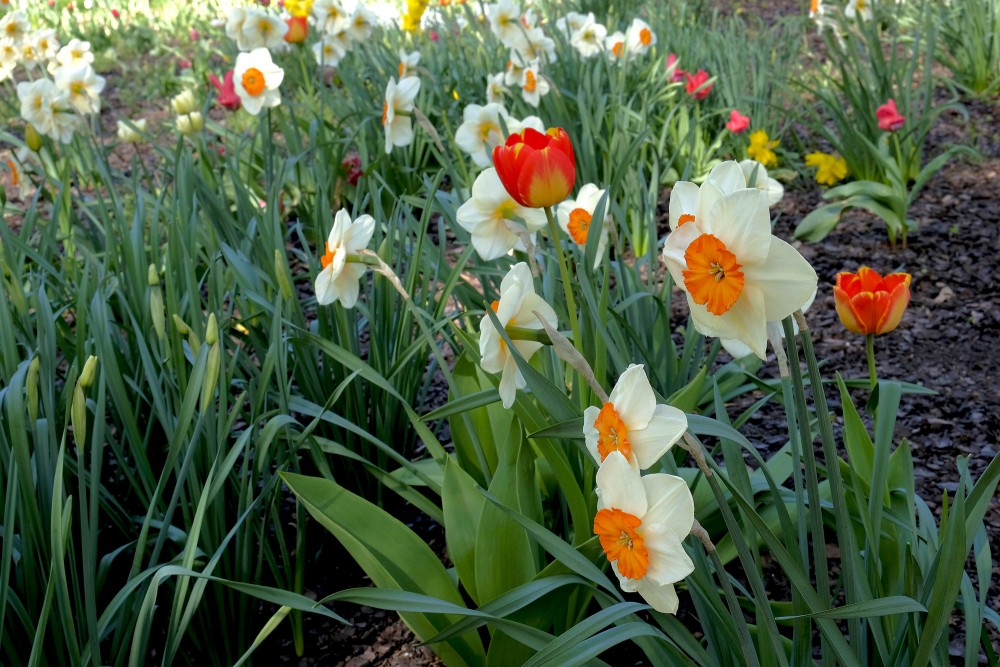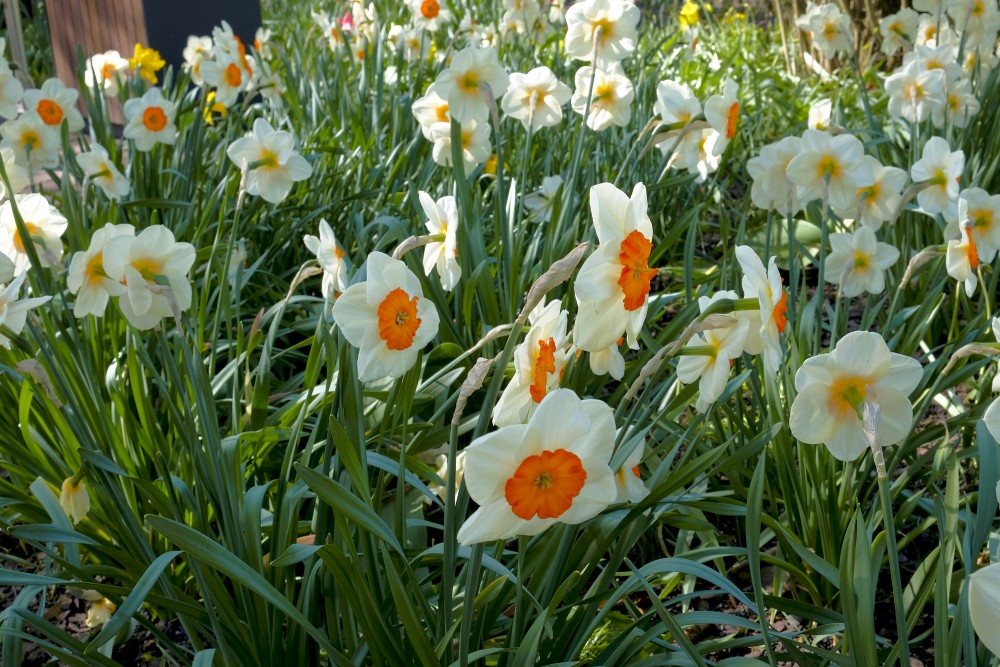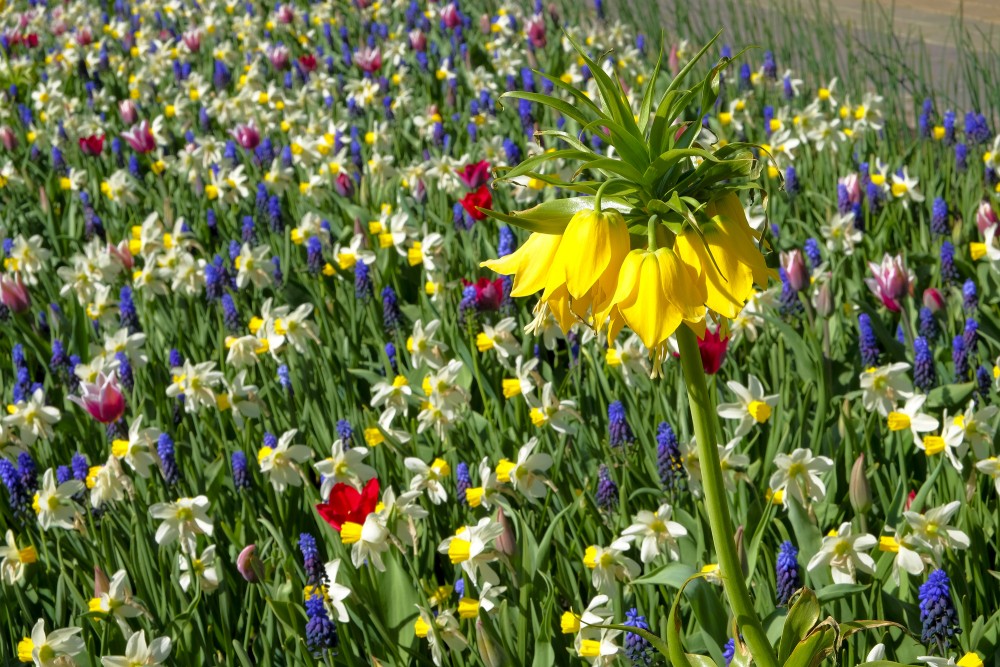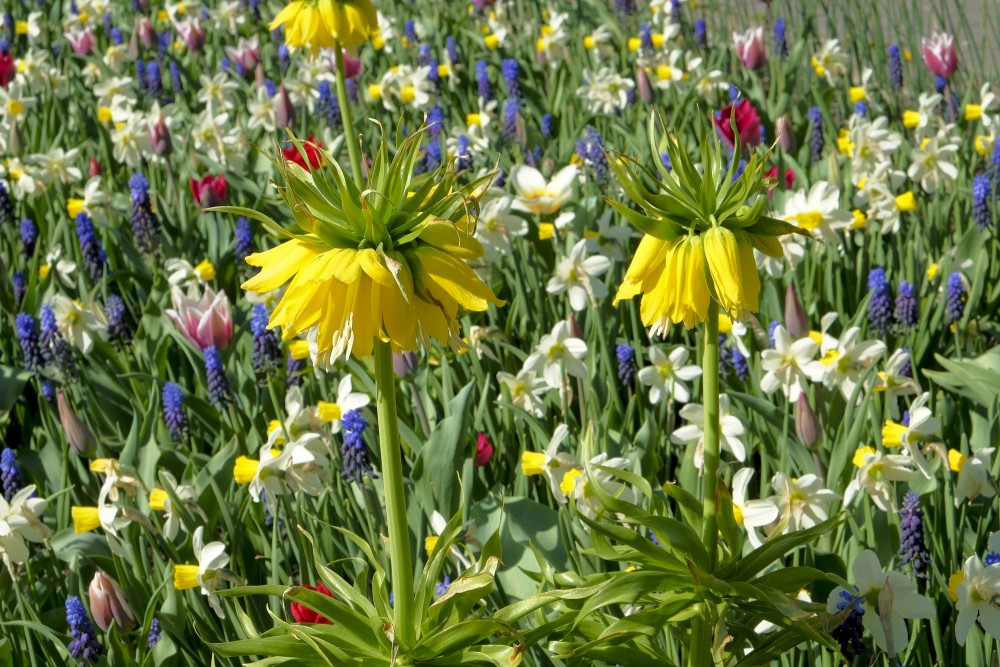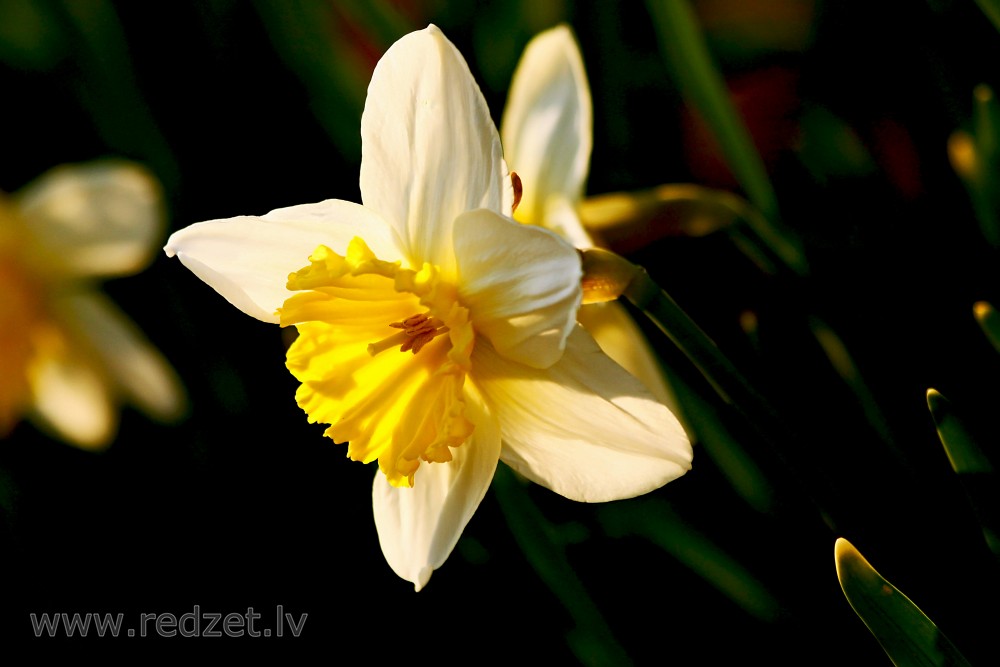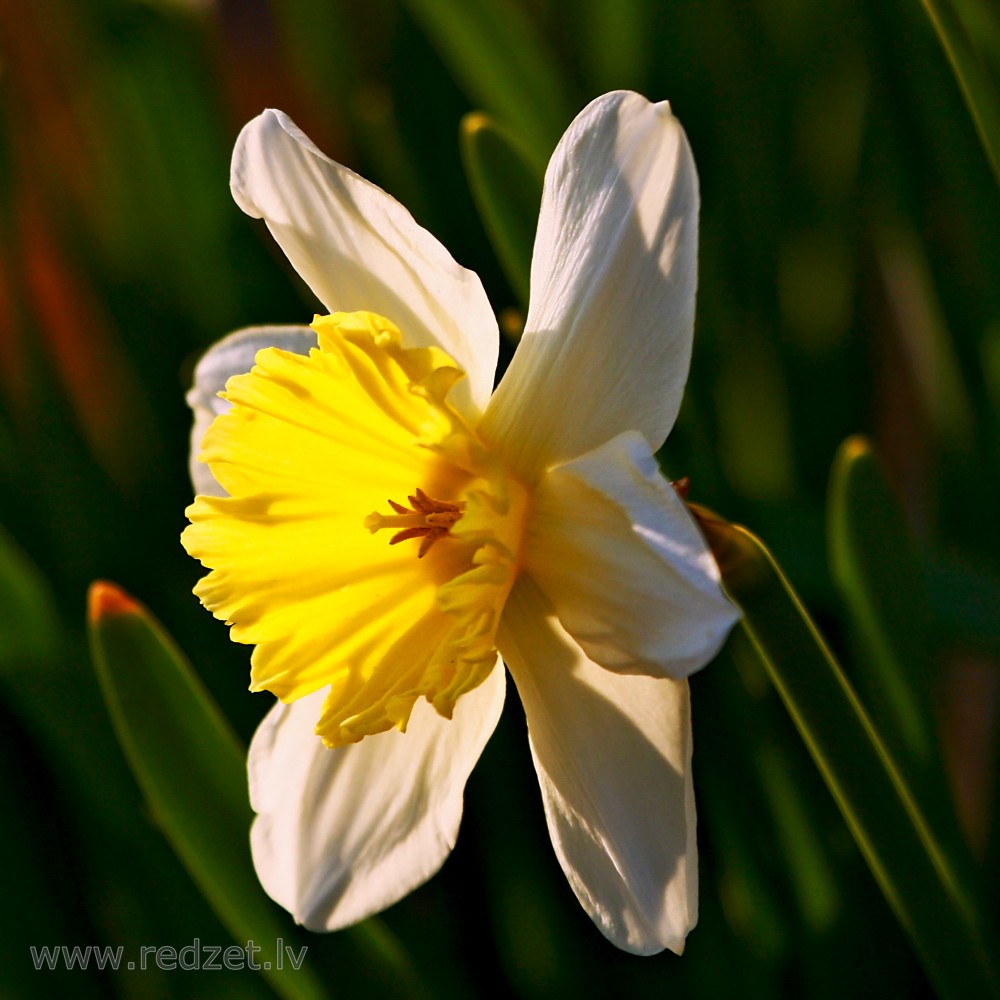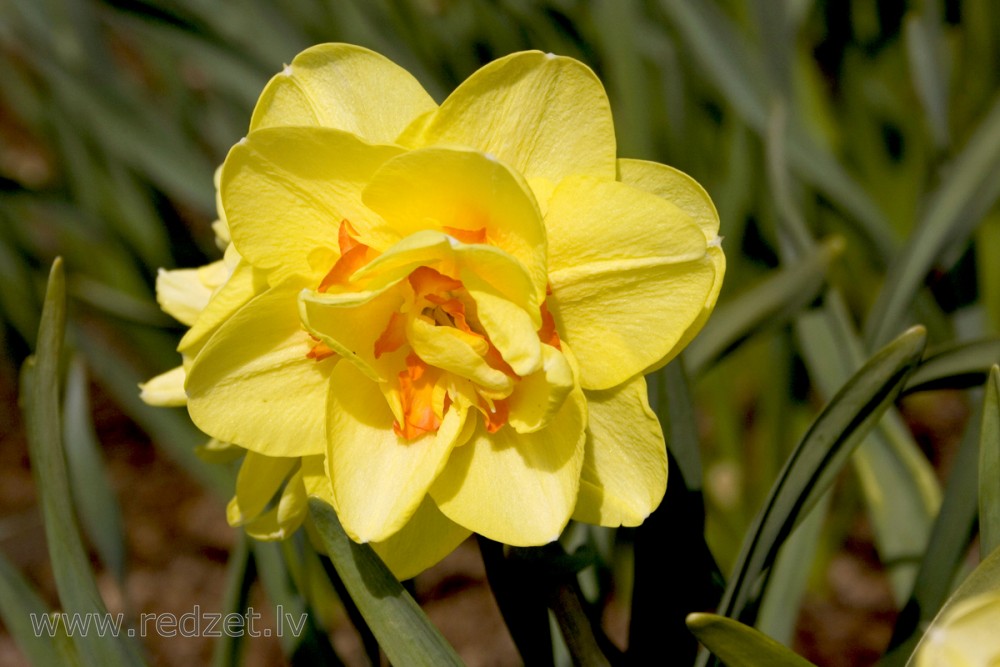Narcissus (plant)
Narcissus is a genus of predominantly spring perennial plants of the Amaryllidaceae (amaryllis) family. Various common names including daffodil, daffadowndilly, narcissus and jonquil are used to describe all or some members of the genus. Narcissus has conspicuous flowers with six petal-like tepals surmounted by a cup- or trumpet-shaped corona. The flowers are generally white or yellow (also orange or pink in garden varieties), with either uniform or contrasting coloured tepals and corona.
Narcissus were well known in ancient civilisation, both medicinally and botanically, but formally described by Linnaeus in his Species Plantarum (1753). The genus is generally considered to have about ten sections with approximately 50 species. The number of species has varied, depending on how they are classified, due to similarity between species and hybridisation. The genus arose some time in the Late Oligocene to Early Miocene epochs, in the Iberian peninsula and adjacent areas of southwest Europe. The exact origin of the name Narcissus is unknown, but it is often linked to a Greek word for intoxicated (narcotic) and the myth of the youth of that name who fell in love with his own reflection. The English word "daffodil" appears to be derived from "asphodel", with which it was commonly compared.
The species are native to meadows and woods in southern Europe and North Africa with a centre of diversity in the Western Mediterranean, particularly the Iberian peninsula. Both wild and cultivated plants have naturalised widely, and were introduced into the Far East prior to the tenth century. Narcissi tend to be long-lived bulbs, which propagate by division, but are also insect-pollinated. Known pests, diseases and disorders include viruses, fungi, the larvae of flies, mites and nematodes. Some Narcissus species have become extinct, while others are threatened by increasing urbanisation and tourism.
Historical accounts suggest narcissi have been cultivated from the earliest times, but became increasingly popular in Europe after the 16th century and by the late 19th century were an important commercial crop centred primarily in the Netherlands. Today narcissi are popular as cut flowers and as ornamental plants in private and public gardens. The long history of breeding has resulted in thousands of different cultivars. For horticultural purposes, narcissi are classified into divisions, covering a wide range of shapes and colours. Like other members of their family, narcissi produce a number of different alkaloids, which provide some protection for the plant, but may be poisonous if accidentally ingested. This property has been exploited for medicinal use in traditional healing and has resulted in the production of galantamine for the treatment of Alzheimer's dementia. Long celebrated in art and literature, narcissi are associated with a number of themes in different cultures, ranging from death to good fortune, and as symbols of spring. The daffodil is the national flower of Wales and the symbol of cancer charities in many countries. The appearance of the wild flowers in spring is associated with festivals in many places.
| Narcissus | |
| Kingdom: | Plantae |
| Clade: | Angiosperms |
| Clade: | Monocots |
| Order: | Asparagales |
| Family: | Amaryllidaceae |
| Subfamily: | Amaryllidoideae |
| Tribe: | Narcisseae |
| Genus: | Narcissus |
Description
Narcissus is a genus of perennial herbaceous bulbiferous geophytes, dying back after flowering to an underground storage bulb. They regrow in the following year from brown-skinned ovoid bulbs with pronounced necks, and reach heights of 5–80 cm depending on the species. Dwarf species such as N. asturiensis have a maximum height of 5–8 cm, while Narcissus tazetta may grow as tall as 80 cm.
The plants are scapose, having a single central leafless hollow flower stem (scape). Several green or blue-green, narrow, strap-shaped leaves arise from the bulb. The plant stem usually bears a solitary flower, but occasionally a cluster of flowers (umbel). The flowers, which are usually conspicuous and white or yellow, sometimes both or rarely green, consist of a perianth of three parts. Closest to the stem (proximal) is a floral tube above the ovary, then an outer ring composed of six tepals (undifferentiated sepals and petals), and a central disc to conical shaped corona. The flowers may hang down (pendent), or be erect. There are six pollen bearing stamens surrounding a central style. The ovary is inferior (below the floral parts) consisting of three chambers (trilocular). The fruit consists of a dry capsule that splits (dehisces) releasing numerous black seeds.
The bulb lies dormant after the leaves and flower stem die back and has contractile roots that pull it down further into the soil. The flower stem and leaves form in the bulb, to emerge the following season. Most species are dormant from summer to late winter, flowering in the spring, though a few species are autumn flowering.
Distribution and habitat
Distribution
Although the family Amaryllidaceae are predominantly tropical or subtropical as a whole, Narcissus occurs primarily in Mediterranean region, with a centre of diversity in the Iberian Peninsula (Spain and Portugal). A few species extend the range into southern France, Italy, the Balkans (N. poeticus, N. serotinus, N. tazetta), and the Eastern Mediterranean (N. serotinus) including Israel (N. tazetta). The occurrence of N. tazetta in western and central Asia, China and Japan are considered introductions, albeit ancient (see Eastern cultures). While the exact northern limit of the natural range is unknown, the occurrences of wild N. pseudonarcissus in Great Britain, middle and northern Europe are similarly considered ancient introductions.
While Amaryllidaceae is not native to North America, it grows well in USDA hardiness zones 3B through 10, which encompass most of the United States and Canada.
N. elegans occurs on the North West African Coast (Morocco and Libya), as well as the coastline of Corsica, Sardinia and Italy, and N. bulbocodium between Tangier and Algiers and Tangier to Marrakech, but also on the Iberian Peninsula. N. serotinus is found along the entire Mediterranean coast. N. tazetta occurs as far east as Iran and Kashmir. Since this is one of the oldest species found in cultivation, it is likely to have been introduced into Kashmir. N. poeticus and N. pseudonarcissus have the largest distribution ranges. N. poeticus ranges from the Pyrenees along the Romanian Carpathians to the Black Sea and along the Dalmatian coast to Greece. N. pseudonarcissus ranges from the Iberian Peninsula, via the Vosges Mountains to northern France and Belgium, and the United Kingdom where there are still wild stocks in Southern Scotland. The only occurrence in Luxembourg is located near Lellingen, in the municipality of Kiischpelt. In Germany it is found mainly in the nature reserve at Perlenbach-Fuhrtsbachtal and the Eifel National Park, where in the spring at Monschau the meadows are teeming with yellow blooms. One of the most easterly occurrences can be found at Misselberg near Nassau on the Lahn.
However unlike the above examples most species have very restricted endemic ranges which may overlap resulting in natural hybrids. For instance in the vicinity of the Portuguese city of Porto where both N. pseudonarcissus and N. triandrus occur there are found various intersections of the two species while in a small area along part of the Portuguese Mondego river are found intersectional hybrids between N. scaberulus and N. triandrus.
The biogeography demonstrates a phylogenetic association, for instance subgenus Hermione having a lowland distribution, but subgenus Narcissus section Apodanthi being montane and restricted to Morocco, Spain and Portugal. The remaining sections within subgenus Narcissus include both lowland and mountain habitats.[60] Section Pseudonarcissus, although widely naturalised is endemic to the Baetic Ranges of the south eastern Iberian peninsula.
Habitats
Their native habitats are very varied, with different elevations, bioclimatic areas and substrates, being found predominantly in open spaces ranging from low marshes to rocky hillsides and montane pastures, and including grassland, scrub, woods, river banks and rocky crevices. Although requirements vary, overall there is a preference for acidic soils, although some species will grow on limestone. Narcissus scaberulus will grow on granite soils where it is moist in the growing season but dry in the summer, while Narcissus dubius thrives best in regions with hot and dry summers.
The Pseudonarcissus group in their natural habitat prefer humid situations such as stream margins, springs, wet pastures, clearings of forests or shrublands with humid soils, and moist hillsides. These habitats tend to be discontinuous in the Mediterranean mountains, producing discrete isolated populations. In Germany, which has relatively little limestone, Narcissus pseudonarcissus grows in small groups on open mountain meadows or in mixed forests of fir, beech, oak, alder, ash and birch trees with well-drained soil.
en.wikipedia.org

